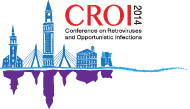Viral load rebound rate of 35% using ritonavir-boosted PI monotherapy: results of five-year PIVOT study
24 March 2014. Related: Conference reports, Antiretrovirals, Treatment strategies, CROI 21 (Retrovirus) 2014.
Simon Collins, HIV i-Base
 A long-term strategy study sponsored by the Medical Research Council (MRC) in the UK reported low rates of serious complications and the potential to reduce drug costs. However, more than a third of people on the ritonavir-boosted PI monotherapy group had viral load rebound compared to only 3% of people on standard combination therapy.
A long-term strategy study sponsored by the Medical Research Council (MRC) in the UK reported low rates of serious complications and the potential to reduce drug costs. However, more than a third of people on the ritonavir-boosted PI monotherapy group had viral load rebound compared to only 3% of people on standard combination therapy.
The PIVOT study randomised 587 UK patients who already had an undetectable viral load on stable treatment to either PI/r monotherapy or triple therapy. It included four years of follow up (median 44 months, maximum 59 months) and the primary endpoints was loss of future treatment options based on development of drug resistance.
Participants in the monotherapy arm were restarted on triple therapy if they had three viral load results >50 copies/mL (including a retested sample), or due to side effects or patient choice. Approximately 80% of people in the boosted PI monotherapy arm used darunavir/r, with 14% using lopinavir/r and 7% using another PI.
Baseline characteristics included median age 44 years (IQR 38-49), 23% women, 60% gay men; 68% white, 28% black, 4% other. Baseline CD4 count and CD4 nadir were 513 cells/mm3 (IQR 392 – 682) and 178 cells/mm3 (IQR 86 – 250), respectively. Median time on ART was 4.0 years (IQR 2.2 – 6.7), having used a median of 4 individual drugs (IQR 3 – 6). Approximately half of participants were using PI-based and half using NNRTI-based treatment at enrolment.
Although loss of treatment options was low in both arms, more people lost treatment options on the PI/r vs the triple therapy arm. These results were 6 (2.1%) vs 2 (0.7%) people [difference 1.4% (95%CI -0.4 to 3.4%), p = 0.15] after 36 months and 6 (2.1%) vs 4 (1.8%) people [difference -0.2% (95%CI -2.5 to 2.46%), p = 0.85] at the end of the trial.
However, viral load rebounded much more frequently in the monotherapy group ( 35% vs 3.2%; difference 31.8% [95%CI 24.5% to 39.0%], p < 0.001). Patients with viral rebound all became undetectable again, either spontaneously or after the addition of two NRTIs.
There were no significant differences between arms by CD4 response (p=0.21), numbers of serious complications (p=0.15) or change in neurocognitive function (change in mean NPZ-score, p=0.86). However, there were less grade 3/4 serious events in the monotherapy group [n=137 vs 159 (46% vs 55%; difference, -8.4%; 95%CI -16.4% to 0.3%), p=0.043].
Although the poster included no details on the higher numbers of deaths in the monotherapy arm (n=6 vs 1), these were apparently largely related to cancers and not attributed to treatment strategy.
Finally, although the results reported overall mean (SE) drug costs of £21,260 (700) vs £30, 230 (860), with the PI/r monotherapy treatment saving £8,970 (-6,790 to -11,160) per person over five years, this did not take account of additional monitoring and costs associated with changing treatment in those patients with viral rebound.
comment
The very high rates of viral rebound in people using PI/r monotherapy makes it unlikely that this study will change prescribing guidelines. Given the volume of data generated from the extensive follow-up it is also frustrating that so little information was included in the poster.
It is unclear why there was no analysis for whether virological failure was related to prior treatment history, choice of boosted PI, adherence (including not taking meds with food), or other factors and it is unclear why details of deaths in the study were not included.
Cost differences based on drug costs alone, rather that as part of a more detailed analysis of total management costs are unhelpful.
A more comprehensive presentation of the results will be presented as an oral session at the upcoming BHIVA conference in Liverpool.
References
Paton N et al. Randomised controlled trial of a PI monotherapy switch strategy for long-term HIV management. 21st CROI, 2014, Boston. Late breaker poster abstract 550LB.

